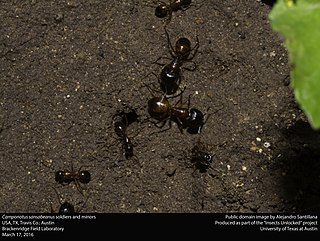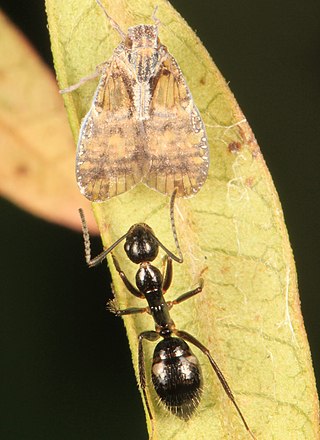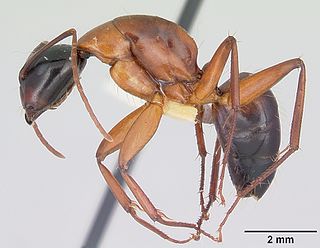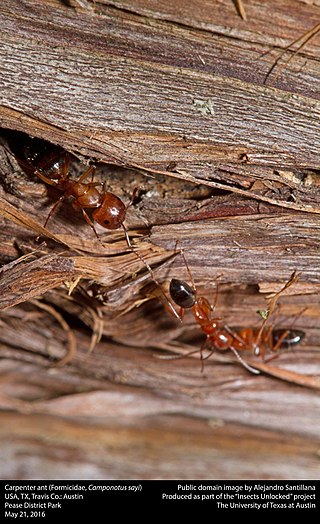
Cardiocondyla is an Old World genus of ants in the subfamily Myrmicinae.

Camponotus sansabeanus is a species of carpenter ant native to the western United States, northern Mexico, Missouri, Arkansas, and Louisiana.

Camponotus sexguttatus is a species of carpenter ant native to South America, Central America, Mexico, and the Caribbean. This species is invasive in Florida, Hawaii, and Arizona.

Pogonomyrmex subdentatus is a species of harvester ant native to California, Nevada, and possibly Oregon and Colorado.

Odontomachus relictus is a species of trapjaw ant in the subfamily Ponerinae native to Florida.

Pogonomyrmex bicolor, the bicolored harvester ant, is a species of harvester ant native to Arizona, Sonora, Chihuahua, and Sinaloa.

Camponotus mina is a species of carpenter ant native to large parts of northern Mexico, California, Arizona, Texas, and New Mexico, and possibly Wyoming, South Dakota, and Minnesota.

Camponotus texanus is a species of carpenter ant native to Texas, Nuevo Leon, and possibly Arizona.

Hypoponera punctatissima, or Roger's ant, is a species of Ponerine ant native to Africa but now found worldwide as a tramp species.

Camponotus ocreatus is a species of carpenter ant native to northern Mexico and the southwestern United States.

Camponotus semitestaceus is a species of carpenter ant native to the western United States, British Columbia, Baja California, and possibly Veracruz.

Camponotus discolor is a species of carpenter ant native to the eastern United States, North Dakota, Nebraska, Texas, Kansas, Oklahoma, Nuevo Leon, Tamaulipas, and possibly California, Montana, Utah, and Colorado.

Pheidole hyatti is a species of big-headed ant native to the southwest United States, Mexico, and Guatemala, invasive in Hawaii, and possibly present in Panama, Bolivia, and Argentina.

Camponotus chromaiodes, known generally as, the ferruginous carpenter ant or red carpenter ant, is a species of carpenter ant native to the eastern United States, Nebraska, Kansas, and possibly California. Acetobacteraceae are found in the guts of workers in this species.

Pogonomyrmex desertorum, the large seed harvesting ant, is a species of harvester ant native to Mexico, the southwestern United States, and possibly Florida and Colorado.

Gnamptogenys hartmani is a species of ectaheteromorph ant native to South America, Central America, Mexico, Texas, and Louisiana.

Camponotus essigi is a species of carpenter ant native to the western United States, possibly Coahuila, and invasive in Trinidad and Tobago.

Camponotus subbarbatus. also known as the bearded carpenter ant, is a species of carpenter ant native to eastern North America.

Camponotus sayi is a species of carpenter ant native to the southwest United States, northern Mexico, and possibly North Dakota, Ontario, Mississippi, North Carolina, South Carolina, and Florida.

Camponotus clarithorax is a species of carpenter ant of the subgenus Camponotus native to California, Oregon, the Baja California Peninsula, and possibly the eastern United States. This species is found in Oregon, California, and Baja California.





















